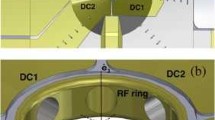Abstract
Ions in radio-frequency traps are widely used in various fields of applied and fundamental physics, such as metrology and quantum computing. One of the important tasks required for modern experiments is deep cooling of ion crystals. The results of simulations of an increase in the efficiency of deep cooling of linear ion crystals by the method of electromagnetically induced transparency (EIT cooling) by imposing an optical lattice on the radio-frequency trap have been reported. It has been shown that this method makes it possible to narrow the frequency range occupied by various vibrational modes of ions and to increase their axial frequencies of motion without violating the linear configuration of the crystal. Thus, for a crystal of eight ions in a Paul trap with secular frequencies ωz = 2π × 100 kHz and ωr = 2π × 650 kHz, the application of an optical lattice allows the reduction of the frequency range occupied by vibrational modes by a factor of 2. The dependence of the optimal power of the optical lattice for narrowing the vibrational spectrum on the number of particles in the trap and its parameters has been investigated.
Similar content being viewed by others
References
C. D. Bruzewicz, J. Chiaverini, R. McConnell, and J. M. Sage, Appl. Phys. Rev. 6, 021314 (2019).
M. Saffman, Nat. Sci. Rev. 6, 24 (2019).
F. Arute, K. Arya, R. Babbush, et al., Nature (London, U.K.) 574, 505 (2019).
J. Zhang, G. Pagano, P. W. Hess, A. Kyprianidis, P. Becker, H. Kaplan, A. V. Gorshkov, Z. X. Gong, and C. Monroe, Nature (London, U.K.) 551, 601 (2017).
H. Bernien, S. Schwartz, A. Keesling, H. Levine, A. Omran, H. Pichler, S. Choi, A. S. Zibrov, M. Endres, M. Greiner, V. Vuletic, and M. D. Lukin, Nature (London, U.K.) 551, 579 (2017).
P. Micke, T. Leopold, S. A. King, E. Benkler, L. J. Spieß, L. Schmöger, M. Schwarz, J. R. Crespo López-Urrutia, and P. O. Schmidt, Nature (London, U.K.) 578, 60 (2020).
T. Rosenband, D. B. Hume, P. O. Schmidt, et al., Science (Washington, DC, U. S.) 319, 1808 (2008).
P. Wang, C. Y. Luan, M. Qiao, M. Um, J. Zhang, Y. Wang, X. Yuan, M. Gu, J. Zhang, and K. Kim, 1, 1 (2020).
J. M. Robinson, E. Oelker, W. R. Milner, W. Zhang, T. Legero, D. G. Matei, F. Riehle, U. Sterr, and J. Ye, Optica 6, 240 (2019).
J. P. Gaebler, T. R. Tan, Y. Lin, Y. Wan, R. Bowler, A. C. Keith, S. Glancy, K. Coakley, E. Knill, D. Leibfried, and D. J. Wineland, Phys. Rev. Lett. 117, 1 (2016).
T. P. Harty, D. T. Allcock, C. J. Ballance, L. Guidoni, H. A. Janacek, N. M. Linke, D. N. Stacey, and D. M. Lucas, Phys. Rev. Lett. 113, 2 (2014).
P. O. Schmidt, T. Rosenband, C. Langer, W. M. Itano, J. C. Bergquist, and D. J. Wineland, Science (Washington, DC, U. S.) 309, 749 (2005).
P. D. Lett, W. D. Phillips, S. L. Rolston, C. E. Tanner, R. N. Watts, and C. I. Westbrook, J. Opt. Soc. Am. B 6, 2084 (1989).
J. I. Cirac and P. Zoller, Phys. Rev. Lett. 74, 4091 (1995).
A. Sørensen and K. Mølmer, Phys. Rev. Lett. 82, 1971 (1999).
C. Monroe, D. M. Meekhof, B. E. King, S. R. Jefferts, W. M. Itano, D. J. Wineland, and P. Gould, Phys. Rev. Lett. 75, 4011 (1995).
G. Morigi, J. Eschner, and C. H. Keitel, Phys. Rev. Lett. 85, 4458 (2000).
M. Roghani and H. Helm, Phys. Rev. A 77, 43418 (2008).
I. Semerikov, I. Zalivako, A. Borisenko, K. Khabarova, and N. Kolachevsky, J. Russ. Laser Res. 39, 568 (2018).
J. Evers and C. H. Keitel, Europhys. Lett. 68, 370 (2004).
D. Leibfried, R. Blatt, C. Monroe, and D. Wineland, Rev. Mod. Phys. 75, 281 (2003).
R. Lechner, C. Maier, C. Hempel, P. Jurcevic, B. P. Lanyon, T. Monz, M. Brownnutt, R. Blatt, and C. F. Roos, Phys. Rev. A 93, 1 (2016).
L. Feng, W. Tan, A. De, A. Menon, A. Chu, G. Pagano, and C. Monroe, Phys. Rev. Lett. 125, 053001 (2020).
T. Lauprêtre, R. B. Linnet, I. D. Leroux, H. Landa, A. Dantan, and M. Drewsen, Phys. Rev. A 99, 031401(R) (2019).
K. Wright, K. Beck, S. Debnath, et al., Nat. Commun. 10, 1 (2019).
Y. Wang, M. Um, J. Zhang, S. An, M. Lyu, J. N. Zhang, L. M. Duan, D. Yum, and K. Kim, Nat. Photon. 11, 646 (2017).
N. Huntemann, M. Okhapkin, B. Lipphardt, S. Weyers, C. Tamm, and E. Peik, Phys. Rev. Lett. 108, 090801 (2012).
R. C. Thompson, Contemp. Phys. 56, 63 (2015).
D. G. Enzer, M. M. Schauer, J. J. Gomez, M. S. Gulley, M. H. Holzscheiter, P. G. Kwiat, S. K. Lamoreaux, C. G. Peterson, V. D. Sandberg, D. Tupa, A. G. White, R. J. Hughes, and D. F. James, Phys. Rev. Lett. 85, 2466 (2000).
D. F. V. James, Appl. Phys. B 66, 181 (1998).
E. Bentine, C. J. Foot, and D. Trypogeorgos, Comput. Phys. Commun. 253, 107187 (2020).
A. Roy, S. De, B. Arora, and B. K. Sahoo, J. Phys. B: At. Mol. Opt. Phys. 50, 205201 (2017).
Acknowledgments
We are grateful to O.Yu. Lakhmanskaya for useful discussions.
Author information
Authors and Affiliations
Corresponding author
Additional information
Russian Text © The Author(s), 2020, published in Pis’ma v Zhurnal Eksperimental’noi i Teoreticheskoi Fiziki, 2020, Vol. 112, No. 9, pp. 626–631.
Funding
This work was supported by the Russian Science Foundation (project no. 19-12-00274).
Rights and permissions
About this article
Cite this article
Akopyan, L.A., Zalivako, I.V., Lakhmanskiy, K.E. et al. Optimization of the Normal Mode Spectrum of Linear Ion Crystals in Paul Traps for EIT Cooling Using an Optical Lattice. Jetp Lett. 112, 585–590 (2020). https://doi.org/10.1134/S0021364020210043
Received:
Revised:
Accepted:
Published:
Issue Date:
DOI: https://doi.org/10.1134/S0021364020210043



